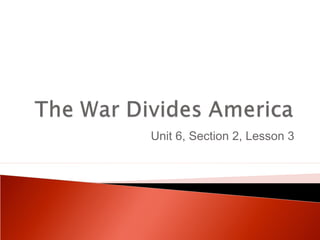
Unit 6 section 2 lesson 3 war divides america (hs tmb240-16090's conflicted copy 2012-08-21)
- 1. Unit 6, Section 2, Lesson 3
- 2. Objectives • Describe the divisions within American society over the Vietnam War. • Analyze the Tet Offensive and the American reaction to it. • Summarize the factors that influenced the outcome of the 1968 presidential election.
- 3. Terms and People • draftee − a young man who was drafted into military service • SDS − Students for a Democratic Society, founded to fight racism but which later campaigned against the Vietnam War • “credibility gap” − the difference between what the Johnson administration said about the war and what journalists in Vietnam saw and reported • Tet Offensive − a coordinated assault, in January 1968, by the Vietcong and North Vietnamese on South Vietnamese cities and bases • Robert Kennedy − New York’s Democratic senator and a candidate for the Democratic Party presidential nomination in 1968
- 4. How did the American war effort in Vietnam lead to rising protests and social divisions back home? President Johnson sent more troops to Vietnam, and in the United States more people questioned the war. The Vietnam War divided Americans more deeply than any conflict since the Civil War.
- 5. “The Living-Room War” Walter Cronkite, the anchor of “We have been too often the CBS Evening News, was disappointed by the optimism the most respected t.v. of the American Leaders, both journalist of the 1960s. in Vietnam and Washington, to have faith any longer in the Cronkite revealed the disconnect silver linings they find in the between Johnson’s optimistic darkest clouds… It seems now statements and the gritty more certain than ever that reality of the fighting. the bloody experience of Vietnam is to end in After visiting Vietnam in stalemate.” February 1968, he told his viewers: What is Cronkite’s criticism of American leaders’ optimism?
- 6. As more troops died and no clear victory emerged, increasing numbers of Americans opposed the Vietnam War. Many people opposed the policies of the draft. • More than 1.5 million young men were drafted during the Vietnam War. • Many argued the draft unfairly gave deferments to students. • Most of the draftees came from a poor or working-class background.
- 7. The number of African Americans fighting in Vietnam was disproportionately high. African Americans were less likely than whites to become commissioned officers. They were more likely to serve, and die, in combat positions.
- 8. Inequalities in the draft led to widespread resistance against the war. In 1969, the draft was restructured to introduce a lottery system.
- 9. Students’ opposition to the war grew. • Colleges and universities became centers of antiwar activism. • Most upper middle-class students opposed the war; working-class students generally supported the war. • Students for a Democratic Society (SDS) campaigned to end the war in Vietnam.
- 10. TV news showed the Beyond college war’s horrors. campuses, more The difference and more between government Americans also reports and news opposed the war. stories created a credibility gap.
- 11. In November 1967, He claimed the Vietcong General Westmoreland had weakened and addressed the nation’s could no longer mount a concerns about the major attack. war. In early 1968, the Vietcong and North Vietnamese launched the Tet Offensive.
- 12. The Tet Offensive attacked major cities and bases in South Vietnam, including the U.S. Embassy in Saigon. The fighting was fierce, but American and South Vietnamese forces eventually drove back the offensive.
- 13. After the Tet The new Secretary of Offensive, U.S. Defense, Clark Clifford, military leaders recommended that became less certain that the President Johnson war could end pursue peace, rather quickly. than victory, in Vietnam.
- 14. Johnson announced he would not run for another term as president. Democratic Senator Eugene McCarthy, who opposed the war, made a strong showing in the New Hampshire primary. Robert Kennedy, a Democratic Senator from New York, also announced his candidacy.
- 15. In 1968 violence stunned the nation. • In April, Rev. Martin Luther King, Jr. was assassinated in Memphis. • Senator Robert Kennedy was assassinated in June, just after he’d won the California Democratic primary. • Police used rough tactics to break up student protests outside the Democratic Convention in Chicago.
- 16. Eventually the Republicans Democrats chose held a more Hubert peaceful Humphrey, convention, Johnson’s Vice choosing President as their Richard M. presidential Nixon as their candidate. presidential candidate.
- 17. Nixon won the 1968 election. • He called for peace with honor in Vietnam. • He appealed to the “silent majority” — people who were not protesting. • He benefited because Democrats were split between Humphrey and George Wallace, a third-party candidate from the South.